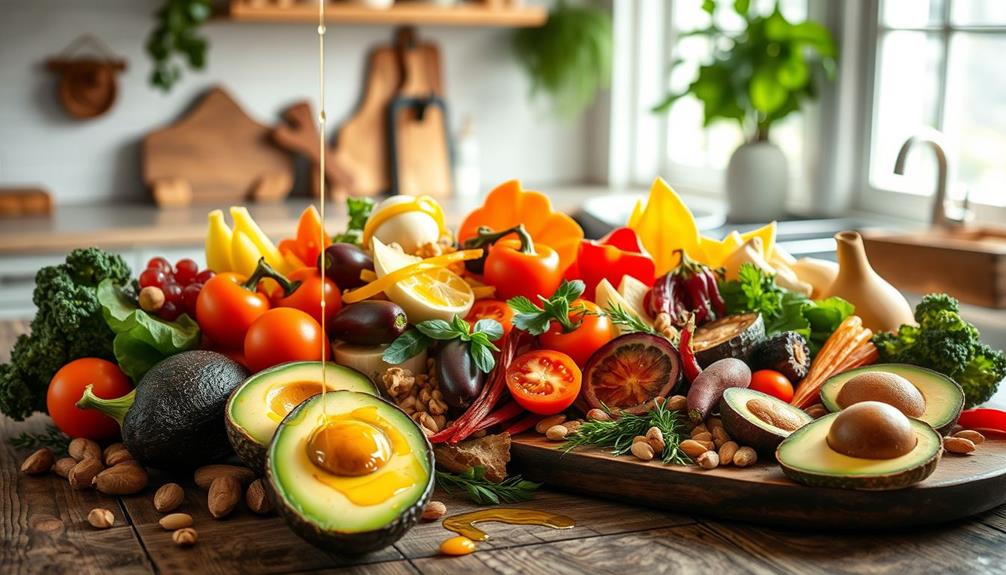To master balanced keto plates, focus on the right macronutrient ratios: 70-75% healthy fats, 20-25% protein, and 5-10% carbs. Fill half your plate with non-starchy vegetables for fiber, dedicate a quarter to high-quality protein like fatty fish or eggs, and the remaining quarter to healthy fats such as avocados or olive oil. Keep portion sizes in check to stay on track with your dietary goals. Variety's key, so mix up your protein and veggies regularly. This approach not only keeps meals exciting but also guarantees you get the nutrients you need. There's plenty more to explore!
Key Takeaways
- Allocate half of your plate to non-starchy vegetables for fiber and essential nutrients, enhancing overall meal quality.
- Dedicate a quarter of your plate to high-quality protein sources like fatty fish and eggs for optimal muscle support.
- Fill the remaining quarter with healthy fats such as avocados and olive oil to promote satiety and flavor in meals.
- Monitor portion sizes using measuring tools or visual aids to maintain the ideal macronutrient ratios for keto success.
- Embrace variety by rotating protein sources, colorful vegetables, and different healthy fats to prevent monotony and ensure a range of nutrients.
Understanding the Keto Diet
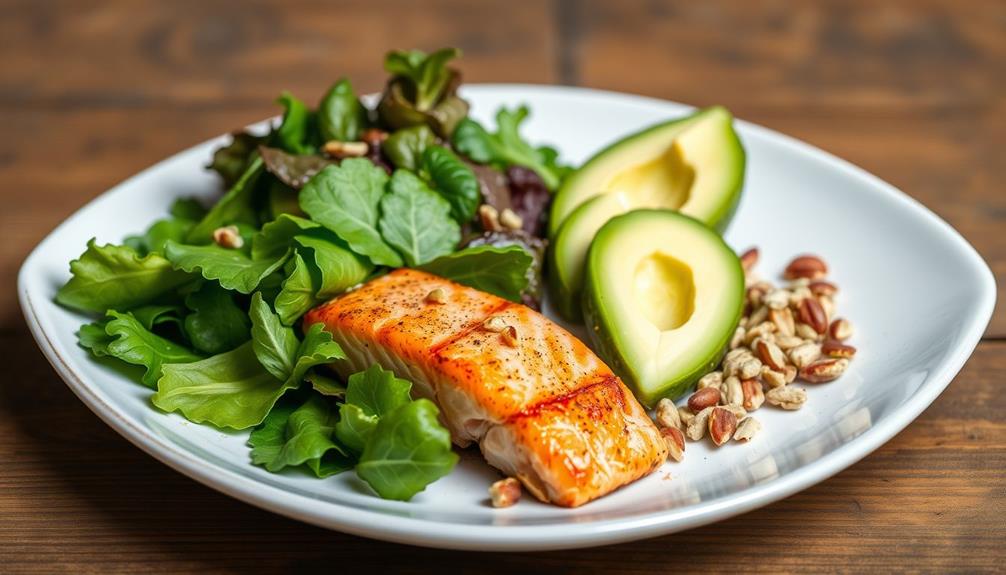
The ketogenic diet, often referred to simply as keto, is a powerful approach to weight loss and metabolic health. By greatly reducing your carb intake to around 20-50 grams per day, you can shift your body into a state of nutritional ketosis.
In this state, your body burns fat for fuel instead of glucose, leading to effective weight loss. You'll likely experience numerous benefits, such as improved blood sugar levels, increased energy, and enhanced mental clarity.
Additionally, keto helps suppress hunger, making it easier to stick to your goals. Customizing your meal plans allows you to cater to your individual health needs, ensuring you enjoy the journey while achieving lasting results.
Embrace this lifestyle change, and watch your body transform.
Ideal Macronutrient Ratios
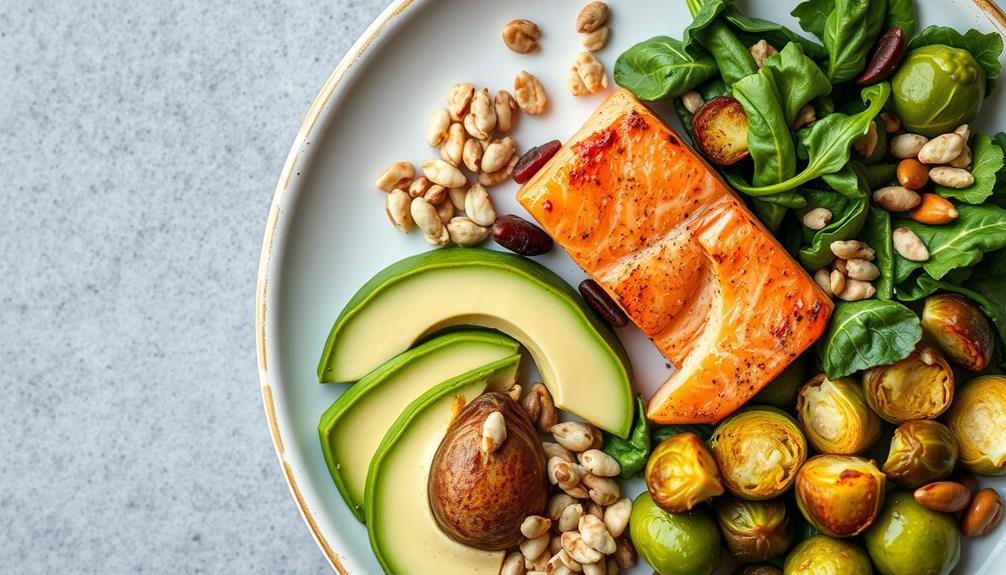
Achieving the right macronutrient ratios is essential for a balanced keto diet.
You'll want to focus on these ideal proportions to help your body thrive:
- 70-75% Fats: Emphasize healthy fats like avocados, olive oil, and nuts to fuel your energy needs.
- 20-25% Protein: Incorporate high-quality protein sources such as fatty fish, eggs, and grass-fed meats to support muscle health.
- 5-10% Carbohydrates: Limit your carb intake to non-starchy vegetables like spinach and broccoli for essential nutrients without spiking insulin levels.
Building Your Keto Plate

Creating a balanced keto plate involves understanding how to effectively combine your macronutrients. Aim to fill half your plate with non-starchy vegetables like spinach or broccoli, which provide essential fiber and nutrients. The other half of your plate should consist of healthy fats and a moderate amount of protein, such as grilled salmon or avocado. By focusing on this balance, you can achieve a state of ketosis, where your body burns fat for fuel instead of carbohydrates. To help you get started, there are plenty of delicious keto recipes available online that can inspire your meals and keep you feeling satisfied while maintaining a ketogenic diet.
Next, allocate a quarter of your plate for high-quality protein sources, such as fatty fish or eggs, to support muscle health. The remaining quarter should be devoted to healthy fats, like avocados or olive oil, to enhance satiety and flavor.
Be mindful of portion sizes to maintain your desired macro ratios while enjoying a variety of tastes and textures. This balanced approach not only satisfies your hunger but also supports your overall health on the keto journey.
Key Foods for Keto Success

Finding the right foods is essential for keto success, as they can make or break your dietary journey.
Focus on incorporating these key foods into your meals:
- Avocados: Packed with potassium and healthy fats, they enhance flavor and satiety.
- Nuts and Seeds: These provide omega-3 fatty acids and protein, making them perfect for snacking or adding crunch to dishes.
- Low-Carb Vegetables: Leafy greens, zucchini, and bell peppers offer essential nutrients while keeping carbs low.
Portion Control Techniques

When it comes to maintaining the right macronutrient ratios on a keto diet, portion control is essential. Start by using measuring cups or a kitchen scale to guarantee you're serving the right amounts of fats, proteins, and vegetables.
Visualize portions by dividing your plate: half for non-starchy veggies, a quarter for protein, and a quarter for healthy fats. Don't forget to track your intake using apps or food diaries; this keeps you accountable and helps you spot patterns.
Additionally, be mindful of your hunger cues—eat slowly and stop when you're satisfied rather than stuffed.
Managing Nutritional Needs
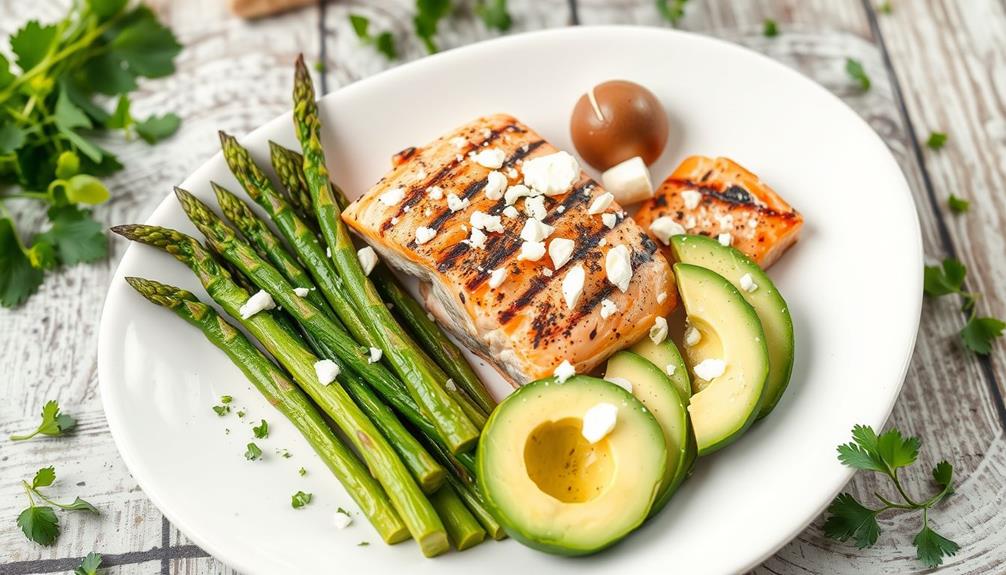
Managing your nutritional needs on a keto diet involves careful attention to your macronutrient intake and overall health.
To maintain balance, focus on these key areas:
- Healthy Fats: Incorporate sources like avocados, olive oil, and nuts to meet your fat intake while enhancing satiety.
- Quality Proteins: Choose fatty fish, eggs, and grass-fed meats to support muscle health and keep you feeling full.
- Low-Carb Vegetables: Fill half your plate with non-starchy veggies like spinach, broccoli, and zucchini for essential nutrients and fiber.
Effective Meal Prep Strategies

To successfully navigate the keto diet, effective meal prep strategies can make all the difference. Start by planning your meals for the week, ensuring you include a balance of healthy fats, proteins, and low-carb vegetables.
Batch cooking is a game-changer; prepare large portions of keto-friendly recipes that you can easily divide into meals. This not only saves time but also helps curb impulsive eating.
Keep keto snacks like nuts, cheese, or homemade keto bars handy for when you're on the go. Don't forget to label your meals with dates to avoid spoilage.
Embracing Variety in Meals
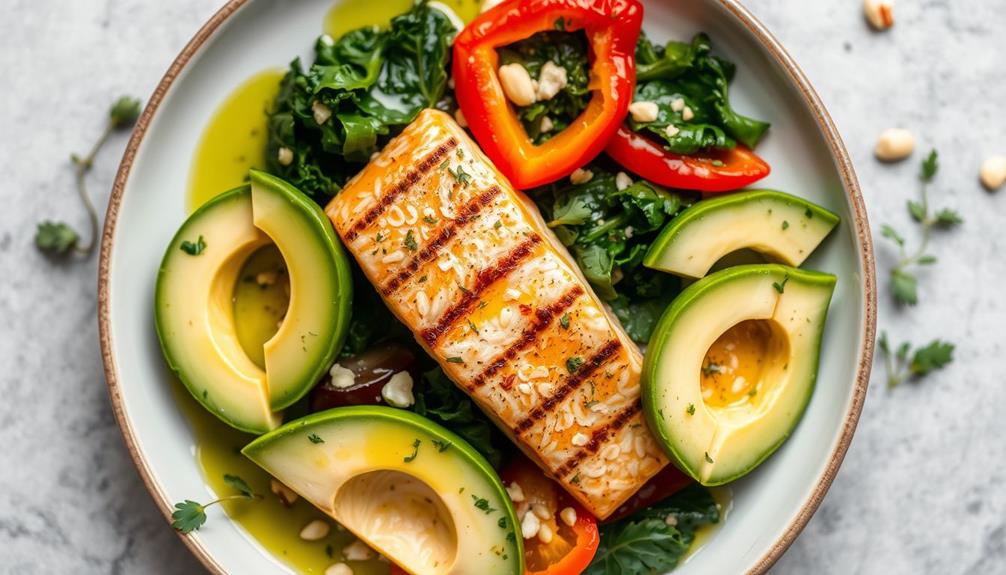
Meal prepping not only helps you stick to your keto guidelines, but it also opens the door to a world of culinary possibilities.
Embracing variety in your meals keeps things exciting and guarantees you get a range of nutrients.
Try incorporating these ideas:
- Flavorful Protein Sources: Switch between grilled chicken, roasted salmon, or spicy shrimp to keep your taste buds engaged.
- Colorful Veggies: Alternate between leafy greens, vibrant bell peppers, and crunchy zucchini for diverse textures and flavors.
- Diverse Fats: Use avocados, olive oil, and nuts to add richness and variety to your dishes.
Frequently Asked Questions
Can I Drink Alcohol on a Ketogenic Diet?
Yes, you can drink alcohol on a ketogenic diet, but choose low-carb options like dry wines or spirits mixed with low-calorie mixers. Stay mindful of your overall carb intake to maintain ketosis effectively.
How Does the Keto Diet Affect Athletic Performance?
Imagine your body as a finely-tuned engine; on keto, it shifts from gasoline to diesel. You'll experience increased endurance and fat-burning efficiency, but initial adaptation may cause fatigue. Listen to your body and adjust accordingly.
What Are Common Mistakes Beginners Make on Keto?
Many beginners on keto often underestimate carb counts, neglect hydration, overlook electrolyte balance, and skip meal prep. You might also struggle with portion control, leading to unintentional overconsumption of fats or proteins.
Can I Eat Out While Following a Keto Diet?
You can eat out while following a keto diet. Just choose dishes with healthy fats and proteins. Don't hesitate to ask for modifications, like extra veggies or sauces on the side, to stay on track.
How Long Does It Take to Enter Ketosis?
It typically takes you about 2 to 7 days to enter ketosis, depending on your diet and activity level. By drastically reducing carbs, your body starts burning fat for fuel instead of glucose.
Conclusion
So, you've mastered the art of balanced keto plates, yet it's ironic that the key to success isn't just in the food itself but in enjoying every bite. As you savor nutrient-dense meals, remember that the journey to health doesn't have to feel like a chore. Embrace the flavors and creativity in your cooking, and you'll find that weight loss and well-being can taste just as good as they feel. Happy cooking!




